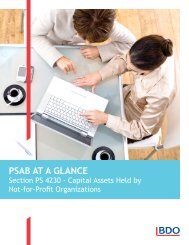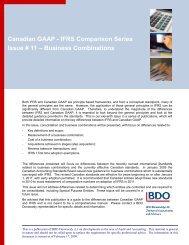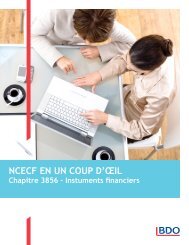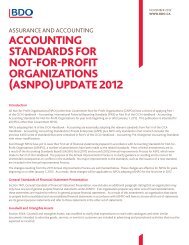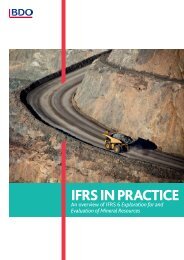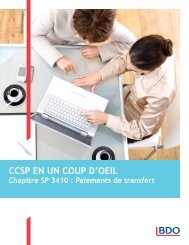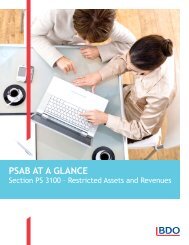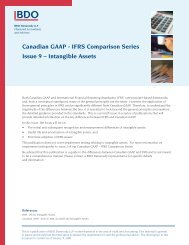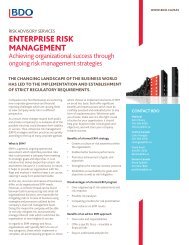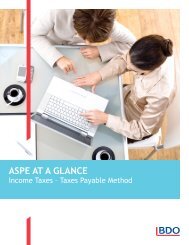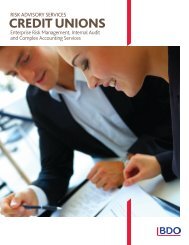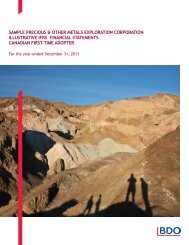Need to Know: IFRS 10 - Consolidated Financial ... - BDO Canada
Need to Know: IFRS 10 - Consolidated Financial ... - BDO Canada
Need to Know: IFRS 10 - Consolidated Financial ... - BDO Canada
- No tags were found...
You also want an ePaper? Increase the reach of your titles
YUMPU automatically turns print PDFs into web optimized ePapers that Google loves.
<strong>IFRS</strong> <strong>10</strong> <strong>Consolidated</strong> <strong>Financial</strong> Statements297.4. Exposure <strong>to</strong> variable returnsThe second criterion an inves<strong>to</strong>r has <strong>to</strong> meet <strong>to</strong> have control over an investee is <strong>to</strong> be exposed <strong>to</strong> variable returnsfrom the investee. Returns are variable if they are not fixed and have the potential <strong>to</strong> vary as a result of theperformance of an investee. These returns can be positive, negative or both positive and negative (<strong>IFRS</strong> <strong>10</strong>.15).Examples of returns are:––Dividends––Interest from debt securities––Changes in the value of the investee––Fees for servicing an investee’s assets or liabilities––Fees and exposure <strong>to</strong> loss from providing credit or liquidity support––Residual interests in the investee’s assets and liabilities on liquidation––Tax benefits––Access <strong>to</strong> future liquidity––Returns that are not available <strong>to</strong> other interest holders that enhance the value of the inves<strong>to</strong>r’s other assets,such as:––Economies of scale cost savings––Sourcing scarce products––Access <strong>to</strong> proprietary knowledge––Limiting some operations or assets (<strong>IFRS</strong> <strong>10</strong>.B57).<strong>IFRS</strong> <strong>10</strong> does not require an inves<strong>to</strong>r <strong>to</strong> be exposed <strong>to</strong> all (or even a majority of) variable returns of the investee. Forexample, non-controlling interests sharing returns with the inves<strong>to</strong>r do not preclude an inves<strong>to</strong>r from meeting the‘exposure <strong>to</strong> variable returns’ criterion (<strong>IFRS</strong> <strong>10</strong>.16).<strong>BDO</strong> commentThe requirements of <strong>IFRS</strong> <strong>10</strong> are subtly but significantly different from IAS 27(2008) and SIC-12. This is because of thewide range of returns that needs <strong>to</strong> be considered, <strong>to</strong>gether with the single control model that contains no thresholdsfor the amount of returns that an inves<strong>to</strong>r needs <strong>to</strong> be exposed <strong>to</strong> in order <strong>to</strong> be considered <strong>to</strong> have control. Inparticular:––IAS 27(2008) refers <strong>to</strong> obtaining ‘benefits’ which can be interpreted as ownership benefits. The <strong>IFRS</strong> <strong>10</strong> definition iswider as it requires a range of other potential benefits <strong>to</strong> be considered, in addition <strong>to</strong> the inves<strong>to</strong>r’s share of profitsand dividends––SIC-12 refers <strong>to</strong> the majority of the benefits whereas <strong>IFRS</strong> <strong>10</strong> refers only <strong>to</strong> being exposed <strong>to</strong> variable returns.Consequently, some structured entities (or SPEs) that were not consolidated under SIC-12 will be consolidated under<strong>IFRS</strong> <strong>10</strong>.



